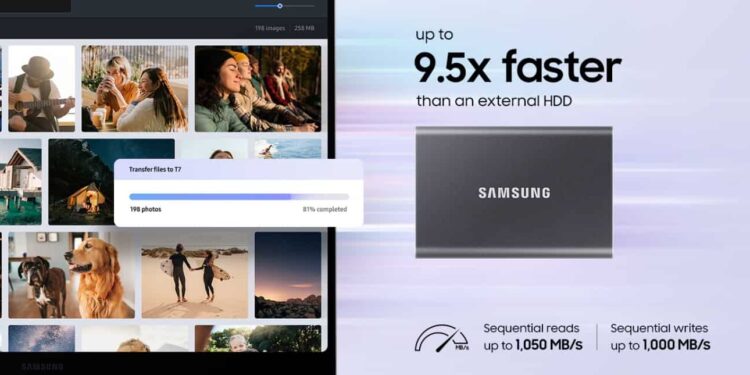When it comes to storage solutions, Samsung is a big name in the industry, providing users with a wide range of external storage devices, especially SSDs. These are pretty fast as compared to their competitors and offer many features that come in handy for those who are constantly moving files from one system to another. The Samsung T7 Shield SSD is a very popular one that provides read and write speeds up to 1050 MB/s and 1000 MB/s, respectively. Given its USB 3.2 Gen 2 interface, the transfer speeds are quite good, and the best thing about this SSD is that it is lightweight and offers 3 storage options: 1 GB, 2 GB, and 3 GB. However, there is an underlying issue faced by many users of this SSD on their Mac systems. According to various reports, the T7 Shield SSD fails to show up on Mac devices as they are not recognized by the system. So, if you too are encountering the same, this is just the guide you need.
Well, it is currently not known whether the issue is related to the T7 SSD or the Mac system itself. Some believe that the T7 SSD is at fault, while others are of the opinion that it is their Mac system’s fault. Anyway, regardless of the cause, we have shared a bunch of effective workarounds for you to try to get rid of this problem.
Also read: Samsung One UI 7 all new features with videos & images
Samsung T7 shield not showing up on Mac: How to fix it
Allow connection with accessories
The best-case scenario is that a single setting on your Mac device is preventing the Samsung T7 Shield from showing up on the system. To fix this, go to the System Settings menu on your Mac, select the Privacy and Security option, and then make sure the Allow Connection with Accessories option is set to Always. Once done, save the changes, and plug in the SSD to check if it is getting detected. If you are lucky, enabling this setting will fix the issue.
Check with other systems
It is possible that the issue occurs due to hardware-related problems. To rule out this possibility, connect the T7 Shield SSD to a Windows system and then check whether it is recognized. If it does, then the problem lies with the Mac system and not the SSD itself. But if the SSD is not recognized on the Windows system as well, then it is most likely a hardware problem.
Format SSD using Windows
Now, this issue can arise if your SSD has files that are corrupted or related reasons. So, what you can try doing is connecting the SSD to a Windows system, and checking whether it is recognized. Chances are that it will. Now, backup all the data from your SSD to your Windows system and right-click on the drive. Now, select the Format option and then make sure exFAT is selected as the Format type. Once done, select Format and wait for the process to be completed. After this, connect the SSD to your Mac to check if the issue persists.
Format SSD using Apple Disk Utility (only if recognized)
If you have a system with a different OS installed, check whether the SSD is getting recognized on it. If yes, backup all the data on the SSD and then connect it to the Mac. Now, you will have to format it. To do so, open the Apple Disk Utility program and then format the connected T7 Shield SSD as APFS encrypted. Using APFS encrypted can result in reduced transfer speeds, so you can try APFS only. Once the format is done, check whether the SSD functions as usual.
Use the original cable provided
If you are using a third-party cable to connect the SSD to your Mac system, this is the reason why it is not being recognized. You have to use the original cable provided by Samsung with the SSD for the best compatibility with the systems. Use the Type C to Type C cable provided for the best results. If the original cable is not available or is damaged, then we recommend getting a cable from the Samsung Store, as third-party cheap cables aren’t capable enough to support such high-speed SSDs.
Check Finder settings
It is also possible that the Finder is not showing the connected SSD on the Sidebar and Desktop as the visibility option is turned off. To fix this, open Finder, go to Settings, and make sure the Show connected hardware on the desktop is turned on. The same applies to the Sidebar settings.
Wait for a few minutes after connecting the SSD to Mac device
It is possible that your Mac system is taking its time to recognize the device and then display it on the Finder. So, we recommend that you wait a few minutes after connecting the SSD to your Mac system for it to be visible. Some users said that the SSD appeared after 4 minutes of being connected to their Mac system. So, waiting might be all you need to do to make sure that your SSD appears.
Upgrade MacOS
This issue can also be the result of incompatibility between your MacOS version and the T7 Shield SSD. So, it is best that you update your macOS to the latest version and then connect your SSD to the system. We are quite optimistic that a full system update can fix the issue for good. So, why not give it a try? Many reported that the issue fixed itself after they updated their MacOS version, therefore, it is worth a shot.
Well, now you know how to deal with the T7 Shield SSD not working issue on Mac. We hope that the workarounds provided in this guide were helpful. If yes, consider visiting Android Gram daily for more such interesting content on all things gaming.


